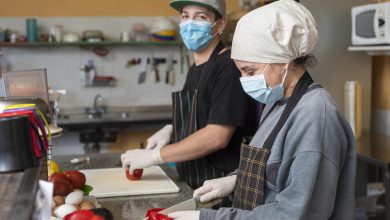Starting a Food Podcast: Sharing Your Culinary Knowledge with the World

Podcasting is an engaging and growing medium, and food podcasts are gaining popularity among listeners who want to learn about recipes, food cultures, cooking tips, and culinary trends. If you’re passionate about food and enjoy sharing your knowledge, starting a food podcast can be a rewarding way to connect with a global audience. Here’s a guide on how to start a successful food podcast, from planning to promotion.
1. Define Your Podcast’s Niche and Audience
Before you begin, it’s essential to define a niche that will make your podcast stand out. The food industry is broad, so finding a specific focus allows you to target a unique audience and cater to their interests.
Popular Food Podcast Niches:
- Cooking Tips and Techniques: Share step-by-step instructions, kitchen hacks, and practical advice for home cooks.
- Culinary Cultures: Dive into the history, traditions, and recipes of specific cuisines from around the world.
- Interviews with Chefs and Food Experts: Connect with culinary professionals and discuss their experiences, philosophies, and insider tips.
- Recipe Development and Food Science: Discuss the science behind cooking and ingredients to educate listeners on how to create dishes successfully.
- Food Trends and Reviews: Cover the latest trends, food products, and restaurant reviews to keep listeners updated on what’s hot.
Choosing a niche gives your podcast a clear focus, helping you attract an audience interested in that particular aspect of food and cooking.
2. Plan Your Content and Format
After choosing your niche, plan the format of your episodes. Your format should fit the type of content you want to deliver and appeal to your target audience.
Common Podcast Formats for Food Shows:
- Solo Commentary: You discuss a specific topic, share recipes, or provide cooking tips in a one-on-one style.
- Interview Format: Invite chefs, food bloggers, or culinary experts to share their insights and experiences.
- Co-hosted: Partner with someone to add more perspective and interaction; this works well for casual discussions and debates.
- Storytelling: Take listeners on a journey through the story of a dish, ingredient, or culinary culture.
- Q&A Sessions: Answer listener questions or offer cooking advice on specific topics.
Decide how often you’ll release episodes—weekly, bi-weekly, or monthly. Consistency is key, so choose a schedule you can commit to over the long term.
3. Invest in Quality Equipment
Good audio quality is essential for a podcast, as poor sound can quickly turn listeners away. Investing in basic podcasting equipment will ensure your episodes sound professional, even if you’re just starting out.
Essential Equipment for Food Podcasts:
- Microphone: A quality microphone, like the Audio-Technica ATR2100x or Blue Yeti, will produce clear, crisp audio.
- Headphones: Good headphones help you monitor sound quality and catch any audio issues during recording.
- Pop Filter: A pop filter minimizes popping sounds that can occur during recording, enhancing audio clarity.
- Recording Software: Software like Audacity (free) or Adobe Audition (paid) allows you to record and edit your episodes.
Using quality equipment will help ensure your podcast sounds polished, which is crucial for attracting and retaining listeners.
4. Choose a Hosting Platform
A podcast hosting platform stores your audio files and distributes them to various podcast directories like Apple Podcasts, Spotify, and Google Podcasts. Choose a platform that fits your budget and provides the necessary features, like analytics and easy distribution.
Popular Podcast Hosting Platforms:
- Buzzsprout: Easy-to-use with great analytics and options for hosting multiple podcasts.
- Anchor: A free platform with built-in editing tools and seamless distribution to major platforms.
- Libsyn: A long-standing platform with powerful features and extensive analytics.
- Podbean: Offers a range of affordable plans and monetisation options for when you’re ready to monetise.
A reliable hosting platform simplifies podcast management, helping you reach more listeners while tracking performance.
5. Create Engaging and Valuable Content
Content is the heart of your podcast. Focus on delivering value in every episode by sharing useful, engaging, and informative content that keeps listeners coming back.
Content Ideas for Food Podcasts:
- Recipe Walkthroughs: Talk listeners through a recipe, offering helpful tips along the way.
- Food History: Share fascinating stories about ingredients or dishes and their cultural significance.
- Chef Interviews: Invite chefs to discuss their favourite dishes, culinary journeys, and tips for home cooks.
- Themed Episodes: Create episodes around themes, such as seasonal cooking, holiday recipes, or specific cuisines.
- Answer Listener Questions: Engage with your audience by answering questions on cooking techniques, ingredients, or trends.
Providing consistently valuable content builds trust and encourages listeners to tune in regularly.
6. Brand Your Podcast
Creating a strong brand helps establish your podcast’s identity and attracts an audience. Your branding includes your podcast’s name, logo, intro music, and overall style.
Branding Tips:
- Choose a Catchy Name: Pick a name that reflects your content and is easy to remember.
- Create a Professional Logo: Use design tools like Canva or hire a designer to create a logo that represents your podcast’s theme.
- Add Intro and Outro Music: A memorable music track adds a professional touch and helps set the tone for each episode.
- Consistent Episode Titles: Write episode titles that are informative and engaging to make it easy for listeners to decide if the episode interests them.
Strong branding creates a recognisable identity that helps your podcast stand out from the competition.
7. Promote Your Podcast
Effective promotion is essential for reaching a wider audience. Use multiple marketing channels to promote your episodes and build a community around your podcast.
Promotion Ideas:
- Social Media: Share episode highlights, quotes, or behind-the-scenes clips on Instagram, Twitter, and Facebook.
- Email Newsletter: Send regular updates to subscribers with episode summaries, recipe links, and exclusive tips.
- Collaborate with Influencers: Partner with food bloggers, chefs, or other podcasters to expand your reach.
- Submit to Directories: Get listed on Apple Podcasts, Spotify, Google Podcasts, and Stitcher for maximum exposure.
- Engage with Listeners: Encourage feedback, questions, and suggestions to make listeners feel part of your community.
Consistent promotion and audience engagement help attract new listeners and increase your podcast’s visibility.
8. Monetise Your Podcast
Once you’ve built a following, you can start thinking about monetisation options. Podcasts can be monetised through sponsorships, affiliate marketing, or listener support.
Monetisation Options for Food Podcasts:
- Sponsorships: Partner with food brands, kitchenware companies, or local restaurants to feature sponsored content.
- Affiliate Marketing: Promote products you love and earn a commission on sales generated through your links.
- Listener Donations: Platforms like Patreon allow fans to support your podcast in exchange for exclusive content.
- Sell Merchandise: Create branded items like aprons, mugs, or recipe e-books for fans to purchase.
With multiple revenue streams, you can turn your food podcast into a profitable venture while continuing to deliver valuable content.
Conclusion
Starting a food podcast is a fantastic way to share your culinary knowledge, connect with food enthusiasts, and build a loyal audience. By choosing a niche, investing in quality equipment, and consistently delivering engaging content, you can create a successful podcast that resonates with listeners. From planning your format to promoting and monetising, each step plays a role in building a memorable podcast experience. Embrace the journey and enjoy sharing your passion for food with listeners around the world.





